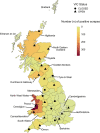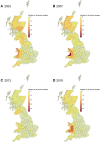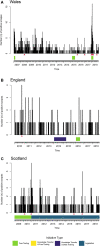Exploiting Scanning Surveillance Data to Inform Future Strategies for the Control of Endemic Diseases: The Example of Sheep Scab
- PMID: 34336966
- PMCID: PMC8322841
- DOI: 10.3389/fvets.2021.647711
Exploiting Scanning Surveillance Data to Inform Future Strategies for the Control of Endemic Diseases: The Example of Sheep Scab
Abstract
Scanning surveillance facilitates the monitoring of many endemic diseases of livestock in Great Britain, including sheep scab, an ectoparasitic disease of major welfare and economic burden. There is, however, a drive to improve the cost-effectiveness of animal health surveillance, for example by thoroughly exploiting existing data sources. By analysing the Veterinary Investigation Diagnosis Analysis (VIDA) database, this study aimed to enhance the use of existing scanning surveillance data for sheep scab to identify current trends, highlighting geographical "hotspots" for targeted disease control measures, and identifying a denominator to aid the interpretation of the diagnostic count data. Furthermore, this study collated and assessed the impact of past targeted disease control initiatives using a temporal aberration detection algorithm, the Farrington algorithm, to provide an evidence base towards developing cost-effective disease control strategies. A total of 2,401 positive skin scrapes were recorded from 2003 to 2018. A statistically significant decline in the number of positive skin scrapes diagnosed (p < 0.001) occurred across the study period, and significant clustering was observed in Wales, with a maximum of 47 positive scrapes in Ceredigion in 2007. Scheduled ectoparasite tests was also identified as a potential denominator for the interpretation of positive scrapes by stakeholders. Across the study period, 11 national disease control initiatives occurred: four in Wales, three in England, and four in Scotland. The majority (n = 8) offered free diagnostic testing while the remainder involved knowledge transfer either combined with free testing or skills training and the introduction of the Sheep Scab (Scotland) Order 2010. The Farrington algorithm raised 20 alarms of which 11 occurred within a period of free testing in Wales and one following the introduction of the Sheep Scab (Scotland) Order 2010. In summary, our analysis of the VIDA database has greatly enhanced our knowledge of sheep scab in Great Britain, firstly by identifying areas for targeted action and secondly by offering a framework to measure the impact of future disease control initiatives. Importantly this framework could be applied to inform future strategies for the control of other endemic diseases.
Keywords: data analysis; diagnostic data; disease control initiatives; existing data; sheep scab; surveillance; temporal aberration detection algorithm.
Copyright © 2021 Geddes, Mohr, Mitchell, Robertson, Brzozowska, Burgess and Busin.
Conflict of interest statement
The authors declare that the research was conducted in the absence of any commercial or financial relationships that could be construed as a potential conflict of interest.
Figures





References
-
- Scottish Government T . The Review of Veterinary Surveillance. (2011) Available online at: www.scotland.gov.uk
-
- UK Surveillance Forum [UKSF] . The UK approach to animal health surveillance. (2019) Available online at: http://www.nationalarchives.gov.uk/doc/open-government-licence/version/3...
-
- Irvine RM. A conceptual study of value chain analysis as a tool for assessing a veterinary surveillance system for poultry in Great Britain. Agric Syst. (2015) 135:143–58. 10.1016/j.agsy.2014.12.007 - DOI
-
- APHA . Veterinary Investigation Diagnosis Analysis (VIDA). (2019) Available online at: http://apha.defra.gov.uk/vet-gateway/surveillance/scanning/vida.htm
LinkOut - more resources
Full Text Sources
Miscellaneous

